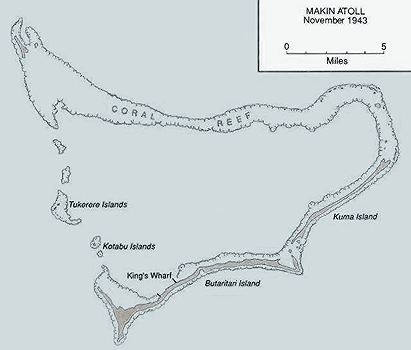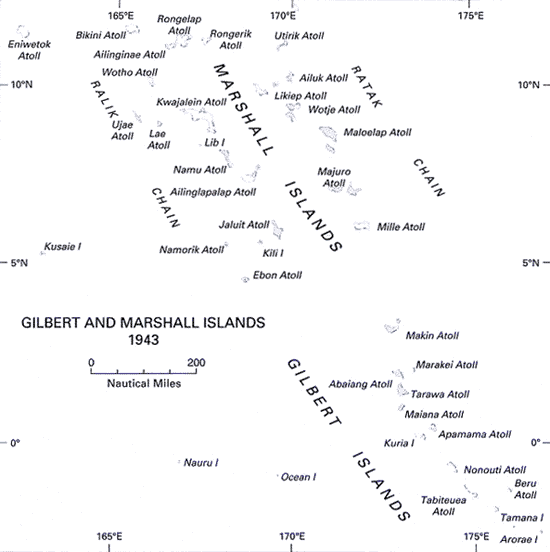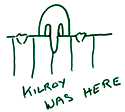The Stamford Historical Society Presents
Pride and Patriotism: Stamford’s Role in World War II
Online Edition
Battles
The Battle of Makin
 The Battle of Makin was fought on Makin Atoll in the Gilbert Islands from 20 November to 24 November 1943. It marked the beginning of an island hopping strategy to approach the Japanese homeland. It had been championed by Admiral Chester Nimitz earlier in 1943, but resources had not been available as Navy forces were tied up in the Aleutian campaign to the north and in the ongoing Solomon Island campaign. With the conclusion of the Alaskan campaign and notable progress against the Japanese in Rabaul, forces and materiels were available for an invasion of the Central Pacific.
The Battle of Makin was fought on Makin Atoll in the Gilbert Islands from 20 November to 24 November 1943. It marked the beginning of an island hopping strategy to approach the Japanese homeland. It had been championed by Admiral Chester Nimitz earlier in 1943, but resources had not been available as Navy forces were tied up in the Aleutian campaign to the north and in the ongoing Solomon Island campaign. With the conclusion of the Alaskan campaign and notable progress against the Japanese in Rabaul, forces and materiels were available for an invasion of the Central Pacific.
The Japanese had taken Makin 10 December 1941 without resistance with a small force of 300 troops and laborers of the Gilberts Invasion Special Landing Force. An initial attack by U.S. troops against Makin had been made 17 August 1942. Then 211 Marines of the 2nd Marine Raider Battalion under Colonel Evans Carlson and James Roosevelt were landed on Makin from the submarines Nautilus (SS-168) and Argonaut (SS-166). Although the Raiders killed 83 Japanese soldiers and lost only 21, nine others were captured and later taken to Kwajalein Atoll and beheaded.
The raid led to the reinforcement of the island by the Japanese. Makin was reinforced with a company of the 5th Special Base Force in August 1942. By July 1943 an airbase was completed on Makin and its defenses were in place. The Marshall Islands were the main target of the United States forces and the Gilberts were the best way to reach them. Thus, 20 July 1943 Admirals Nimitz and Ernest King decided to capture Tarawa and Abemama atolls in the Gilberts, plus Nauru Island. The operation was codenamed Galvanic. On 4 September 1943 the US 5th Fleet’s amphibious troops were designated the V Amphibious Corps under Major General Holland M. Smith, US Marine Corps. It had two divisions: the 2nd Marine Division and the U.S. Army’s 27th Infantry Division. The 27th had 16,000 men in three regiments: the 105th, 106th and 165th Infantry Regiments plus the 105th Field Artillery Battalion and the 193rd Tank Battalion under Major General Ralph Smith. By 28 September 1943 the 27th had been given Makin as a target. Japanese losses in the Solomons forced the Japanese Command to not reinforce or aid the garrisons at Tarawa and Makin.
The Japanese on Makin were garrisoned on the main island, Butaritari, and consisted of 798 men: 284 troops of the 3rd Special Base Force, 100 aviation land personnel, 276 men of the 4th Fleet Construction Unit and all commanded by Lt. j.g. Seizo Ishikawa. Most troops had no combat training and had no weapons. Although some defenses had been constructed, the outnumbered Japanese had no chance of victory. Following U.S. air operations which started 13 November, troops went ashore 20 November. Four days later the island was secure.
The US force suffered 66 killed, 185 wounded. The Japanese had 700 killed, 3 Japanese captured, and 101 Korean laborers captured.

The Battle of Makin
From the U.S. Army Center of Military History:
Central Pacific 1941-1943
 Introduction
Introduction
Veterans
Battles
Stamford Service Rolls
Homefront
Exhibit Photos
Opening Day

